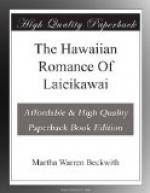To the text such ethnological notes have been added as are needed to make the context clear. These were collected in the field. Some were gathered directly from the people themselves; others from those who had lived long enough among them to understand their customs; others still from observation of their ways and of the localities mentioned in the story; others are derived from published texts. An index of characters, a brief description of the local background, and an abstract of the story itself prefaces the text; appended to it is a series of abstracts from the Fornander collection, of Hawaiian folk stories, all of which were collected by Judge Fornander in the native tongue and later rendered into English by a native translator. These abstracts illustrate the general character of Hawaiian story-telling, but specific references should be examined in the full text, now being edited by the Bishop Museum. The index to references includes all the Hawaiian material in available form essential to the study of romance, together with the more useful Polynesian material for comparative reference. It by no means comprises a bibliography of the entire subject.
Footnotes to Section I: Introduction
[Footnote 1: Compare the Fijian story quoted by Thomson (p. 6).]
[Footnote 2: Daggett calls the story “a supernatural folklore legend of the fourteenth century,” and includes an excellent abstract of the romance, prepared by Dr. W.D. Alexander, in his collection of Hawaiian legends. Andrews says of it (Islander, 1875, p. 27): “We have seen that a Hawaiian Kaao or legend was composed ages ago, recited and kept in memory merely by repetition, until a short time since it was reduced to writing by a Hawaiian and printed, making a duodecimo volume of 220 pages, and that, too, with the poetical parts mostly left out. It is said that this legend took six hours in the recital.” In prefacing his dictionary he says: “The Kaao of Laieikawai is almost the only specimen of that species of language which has been laid before the public. Many fine specimens have been printed in the Hawaiian periodicals, but are neither seen nor regarded by the foreign community.”]
[Footnote 3: The changes introduced by these editors have not been followed in this edition, except in a few unimportant omissions, but the popular song printed below appears first in its pages:
“Aia Laie-i-ka-wai
I ka uka wale la o Pali-uli;
O ka nani, o ka nani,
Helu ekahi o ia uka.
“E nanea e walea ana paha,
I ka leo nahenahe o na manu.
“Kau mai Laie-i-ka-wai
I ka eheu la o na manu;
O ka nani, o ka nani,
Helu ekahi o Pali-uli.
“E nanea, etc.
“Ua lohe paha i ka hone mai,
O ka pu lau-i a Malio;
Honehone, honehone,
Helu ekahi o Hopoe.
“E nanea, etc.”
Behold Laieikawai
On the uplands of Paliuli;
Beautiful, beautiful,
The storied one of the uplands.




